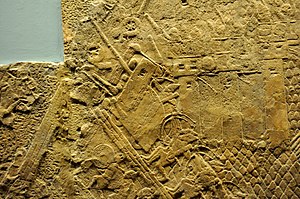Sennacherib's campaign in the Levant
Sennacherib's campaign in the Levant took place in 701 BCE, when Sennacherib turned from Babylonia to the western part of the Neo-Assyrian Empire, where Hezekiah of Judah, incited by Egypt and Marduk-apla-iddina II, had renounced Assyrian allegiance. The rebellion involved various small states in the area: Sidon and Ashkelon were taken by force and a string of other cities and states, including Byblos, Ashdod, Ammon, Moab and Edom then paid tribute without resistance. Ekron called on Egypt for help but the Egyptians were defeated. Sennacherib then turned on Jerusalem, Hezekiah's capital. He besieged the city and gave its surrounding towns to Assyrian vassal rulers in Ekron, Gaza and Ashdod. However, Sennacherib did not breach the city,[2] and Hezekiah remained on his throne as a vassal ruler.[3]
Timeline
Phoenicia, Philistia and Transjordan
The rebellion involved various small states in the area: Sidon and Ashkelon were taken by force and a string of other cities and states, including Byblos, Ashdod, Ammon, Moab and Edom then paid tribute without resistance. Ekron called on Egypt for help but the Egyptians were defeated.
Kingdom of Judah
Sennacherib then turned on Jerusalem, Hezekiah's capital. He besieged the city and gave its surrounding towns to Assyrian vassal rulers in Ekron, Gaza and Ashdod. However, Sennacherib did not breach the city,[2] and Hezekiah remained on his throne as a vassal ruler.[3]
References
- "Sennacherib's Annals". Retrieved 1 April 2018.
- Grayson 1991, p. 110.
- Grabbe 2003, p. 314.
